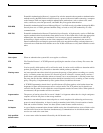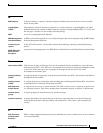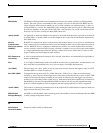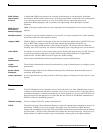
Glossary
GL-14
User Guide for Cisco Secure Access Control System 5.3
OL-24201-01
PI (Programmatic
Interface)
The ACS PI is a programmatic interface that provides external applications the ability to communicate
with ACS to configure and operate ACS; this includes performing the following operations on ACS
objects: create, update, delete and read.
policy condition
Rule-based single conditions that are based on policies, which are sets of rules used to evaluate an
access request and return a decision.
policy element
Global, shared object that defines policy conditions (for example, time and date, or custom conditions
based on user-selected attributes) and permissions (for example, authorization profiles). Policy
elements are referenced when you create policy rules.
port setting
You can configure ACS to authenticate using different LDAP servers, or different databases on the
same LDAP server, by creating more than one LDAP instance with different IP addresses or port
settings.
PPP (Point-to-Point
Protocol)
PPP is a protocol for communication between two computers using a serial interface, typically a
personal computer connected by phone line to a server. For example, your Internet server provider
may provide you with a PPP connection so that the provider's server can respond to your requests, pass
them on to the Internet, and forward your requested Internet responses back to you. PPP uses the
Internet Protocol (IP) and is designed to handle others. It is sometimes considered a member of the
TCP/IP suite of protocols. Relative to the Open Systems Interconnection (OSI) reference model, PPP
provides layer 2 (data-link layer) service. Essentially, it packages your computer's TCP/IP packets and
forwards them to the server where they can actually be put on the Internet.
protocol
A protocol is the special set of rules that end points in a telecommunication connection use when they
communicate. Protocols exist at several levels in a telecommunication connection. For example, there
are protocols for the data interchange at the hardware device level and protocols for data interchange
at the application program level. In the standard model known as Open Systems Interconnection
(OSI), there are one or more protocols at each layer in the telecommunication exchange that both ends
of the exchange must recognize and observe. Protocols are often described in an industry or
international standard.
Proxy
An HTTP Proxy is a server that acts as a middleman in the communication between HTTP clients and
servers.
Public Key
In Cryptography a publicKey is a value provided by some designated authority as an Encryption Key
that, combined with a private key derived from the public key, can be used to effectively encrypt
messages andDigital Signatures.
The use of combined public and private keys is known as asymmetric cryptography. A system for
using public keys is called a public key infrastructure (PKI).
Public Key
Infrastructure (PKI)
A PKI enables users of a basically unsecure public network such as the Internet to securely and
privately exchange data and money through the use of a public and a private cryptographic key pair
that is obtained and shared through a trusted authority. The Public Key infrastructure provides for a
Digital Certificate that can identify an individual or an organization and directory services that can
store and, when necessary, revoke the certificates. Although the components of a PKI are generally
understood, a number of different vendor approaches and services are emerging. Meanwhile, an
Internet standard for PKI is being worked on.


















